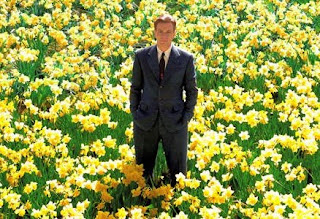By seamlessly conjoining shots through match cutting (also referred to as continuity cutting), film viewers were encouraged to become involved in the illusion that they were watching, not a film made up of multiple bits and pieces of celluloid, but an unmediated reality. (165)Fellini used the editing, not to create an objective sense of reality, but rather to inv
ite the audience into Guido's mind. He throws continuity out the window and the film becomes a actual memory, with choppy edits and changing backgrounds to symbolize the distorting process of a memory and how uncertain they may be. It mirrors the wishful thinking and dreams of Guido as well as the visions of a traumatized child. It is a psychological ploy to step directly into the mind of the character.  the flashback either follows that of the movie, or is flawless and almost dreamlike. For example, the movie Big Fish, which is predominantly told through the main characters flashbacks. However, whenever we do get a glimpse into his mind, it is a whole different world, mostly distinguished through the use of bright, fairytale like colors.
the flashback either follows that of the movie, or is flawless and almost dreamlike. For example, the movie Big Fish, which is predominantly told through the main characters flashbacks. However, whenever we do get a glimpse into his mind, it is a whole different world, mostly distinguished through the use of bright, fairytale like colors.
In many films, a fantasy or flashback is preceded by a ripple effect or a fading of the outline to distinguish the difference between reality and illusion. A look into the characters dilemmas through blurry images, harping music and an echoing subconscious. It distances the audience, rather than what Fellini intended to do in 8 1/2. It might be done by a particular repeating sound, such as in the show LOST, or maybe through a flash of lighting. But in many of these cases, the editing of
 the flashback either follows that of the movie, or is flawless and almost dreamlike. For example, the movie Big Fish, which is predominantly told through the main characters flashbacks. However, whenever we do get a glimpse into his mind, it is a whole different world, mostly distinguished through the use of bright, fairytale like colors.
the flashback either follows that of the movie, or is flawless and almost dreamlike. For example, the movie Big Fish, which is predominantly told through the main characters flashbacks. However, whenever we do get a glimpse into his mind, it is a whole different world, mostly distinguished through the use of bright, fairytale like colors. Another example from a black and white movie would be Orson Welles, Citizen Kane. The movie alternates between the present and the past after the death of Kane and this clip shows on the first flashbacks to Kane's childhood. When the scene goes into the flashback of the main subject as a child, much as it does in 8 1/2, the shots fade into one another and the document we once saw slowly becomes a snowy day. The music also becomes louder and more involved, but the scene continues in a very cinematic manner.
No comments:
Post a Comment